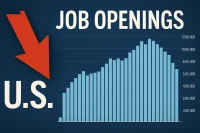Hybrid work phase-out is no longer speculation it’s happening now. Once hailed as the future of work, hybrid and flexible arrangements are facing growing pushback. Major employers are cutting back on remote options, management is enforcing stricter policies, and “hybrid fatigue” is setting in even as many employees resist returning to office norms. In mid‑2025, this shift signals deeper tensions around productivity, collaboration, and corporate culture. Here’s a comprehensive look at why the hybrid vision is fading and what’s driving the quiet unravelling of flexible work.
Table of Contents
The Rise and Stall of Hybrid Work
From Boom to Plateau
Hybrid work skyrocketed post‑pandemic but has recently seen signs of reversal. The number of required in-office days increased across industries, and companies mandating zero office days have steadily declined. While hybrid work remains common, the model has entered a phase of flux.
Hybrid by Default, Not Design
Despite high adoption, hybrid models are often haphazard without clear guidelines, expectations, or equitable practices. Many employers are struggling to ensure consistency and inclusiveness in their approach.
Companies Reinstate Office Mandates
Major Names Tightening Policies
Recent months have seen prominent employers revisit their hybrid policies:
- Companies like John Lewis now require head-office staff to be office‑based at least three days a week.
- Financial institutions such as HSBC are shifting to universal mandates that require three office days across locations.
- Major global firms including Amazon, JP Morgan, and TikTok have adopted more structured, in-office mandates.
Culture as Justification
Organizations argue that physical presence supports spontaneous collaboration, mentoring, innovation, and productivity factors they believe are diluted in remote setups.
The Pushback: Workers Push for Flexibility
Talent Preferences Shift
The majority of workers especially younger professionals and caregivers consistently prefer hybrid arrangements. Flexibility has become a non-negotiable benefit for many.
Talent Exodus Risk
Employers enforcing strict office mandates risk losing top performers, particularly those who value autonomy or require flexible conditions to balance personal responsibilities.
Equity Concerns
Remote flexibility is especially important for working parents, caregivers, rural professionals, and individuals with accessibility needs. Blanket mandates risk reducing inclusiveness.

Hidden Costs of the Hybrid Backlash
Collaboration vs. Deep Work
Hybrid models can improve focus when structured effectively. However, a rigid return to the office can disrupt deep work and reintroduce constant interruptions without enhancing collaboration.
Office Economics & Underutilization
Most offices are still under-occupied compared to pre-pandemic levels. Requiring higher in-person attendance may drive up costs without yielding proportional productivity gains.
Narrowing Talent Pools
Rigid in-office expectations can disqualify remote or underrepresented candidates, restricting access to diverse talent and innovation.
The Shift to “Blended” Work Models
AI-Driven Hybrid
Experts suggest a new model blended work combining flexible locations, AI integration, and task-based scheduling, which aligns better with modern productivity needs.
Outcome-Based Management
Leading organizations are moving away from presenteeism and toward performance-based assessments, using tools like OKRs and digital tracking to focus on results rather than attendance.
Strategies for Employers
Build Intentional Hybrid Policies
- Define specific requirements by role and team.
- Gather employee feedback to balance needs and performance.
- Use formal hybrid playbooks to outline rules and responsibilities.
Prioritize Tech and Inclusion
Invest in equal-access tools, cybersecurity infrastructure, and smart scheduling platforms. Ensure remote employees have parity in meetings and decision-making.
Foster Culture and Well‑Being
Plan meaningful in-person interactions while maintaining flexible schedules. Encourage mental health days, shared calendars, and asynchronous communication norms.
Pilot & Measure
Experiment with different hybrid structures and track key metrics like retention, engagement, and productivity. Adjust policies based on data.
What Employees Should Do
- Clarify expectations with managers.
- Track contributions and advocate for outcome-based evaluations.
- Stay informed about evolving workplace trends.
- Sharpen digital and communication skills to thrive in both remote and in-person settings.
🚀 Find Flexible & Future-Ready Jobs on WhatJobs
Is your current role at risk due to the hybrid work phase-out?
Explore remote, hybrid, and transition-friendly opportunities in Business, Tech, Operations, and more — built for today’s changing workforce.
WhatJobs connects you with adaptable employers who value flexibility, innovation, and skill growth.
👉 Browse flexible jobs now — and stay ahead of the curve.Conclusion: The Hybrid Mirage Fades but Flexibility Can Survive
The hybrid model that emerged post-2020 is now being reassessed, and in some cases reversed. But flexibility isn’t vanishing—it’s evolving. Employers that intentionally redesign hybrid models around productivity, trust, and inclusivity will stay competitive. As hybrid norms recede, what takes their place must be more adaptive, data-driven, and human-centered.
FAQs
Q: Are many companies ditching hybrid?
A: A growing number are tightening hybrid rules, but most still offer some flexibility. Fully remote roles are becoming rarer.
Q: Why mandate office presence now?
A: Employers argue it boosts collaboration, learning, and oversight. They’re also concerned about maintaining company culture.
Q: Does hybrid affect productivity?
A: Data is mixed. While some teams excel in hybrid setups, others face challenges without structured coordination.
Q: Will hybrid return fully?
A: Likely not in its current form. Future models will likely combine AI, location flexibility, and performance metrics.




